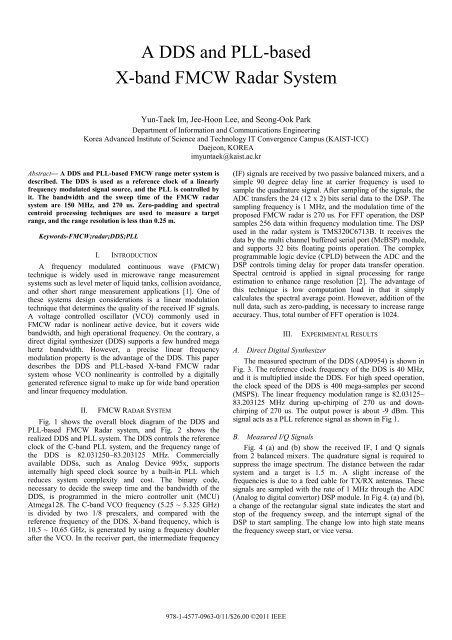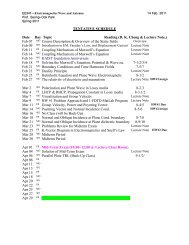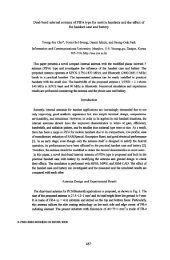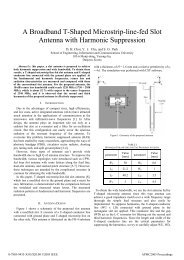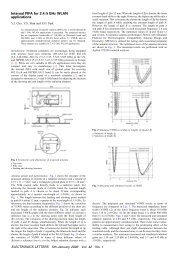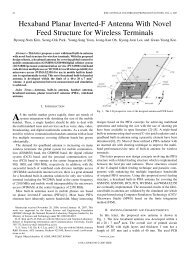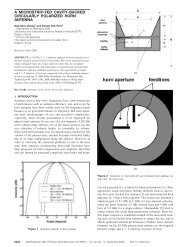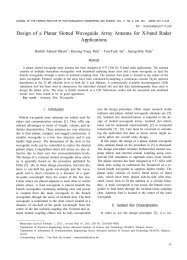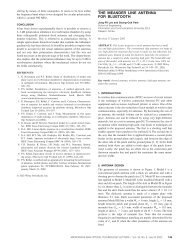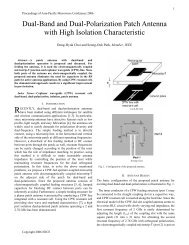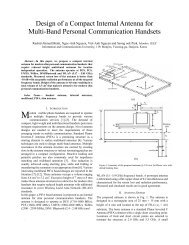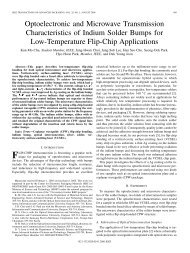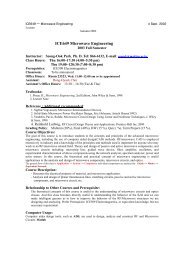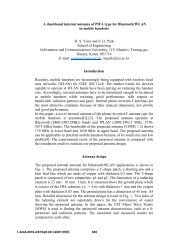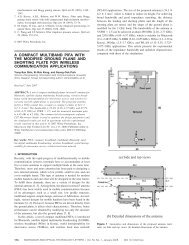A DDS and PLL-based X-band FMCW Radar System
A DDS and PLL-based X-band FMCW Radar System
A DDS and PLL-based X-band FMCW Radar System
Create successful ePaper yourself
Turn your PDF publications into a flip-book with our unique Google optimized e-Paper software.
A <strong>DDS</strong> <strong>and</strong> <strong>PLL</strong>-<strong>based</strong><br />
X-b<strong>and</strong> <strong>FMCW</strong> <strong>Radar</strong> <strong>System</strong><br />
Yun-Taek Im, Jee-Hoon Lee, <strong>and</strong> Seong-Ook Park<br />
Department of Information <strong>and</strong> Communications Engineering<br />
Korea Advanced Institute of Science <strong>and</strong> Technology IT Convergence Campus (KAIST-ICC)<br />
Daejeon, KOREA<br />
imyuntaek@kaist.ac.kr<br />
Abstract— A <strong>DDS</strong> <strong>and</strong> <strong>PLL</strong>-<strong>based</strong> <strong>FMCW</strong> range meter system is<br />
described. The <strong>DDS</strong> is used as a reference clock of a linearly<br />
frequency modulated signal source, <strong>and</strong> the <strong>PLL</strong> is controlled by<br />
it. The b<strong>and</strong>width <strong>and</strong> the sweep time of the <strong>FMCW</strong> radar<br />
system are 150 MHz, <strong>and</strong> 270 us. Zero-padding <strong>and</strong> spectral<br />
centroid processing techniques are used to measure a target<br />
range, <strong>and</strong> the range resolution is less than 0.25 m.<br />
Keywords-<strong>FMCW</strong>;radar;<strong>DDS</strong>;<strong>PLL</strong><br />
I. INTRODUCTION<br />
A frequency modulated continuous wave (<strong>FMCW</strong>)<br />
technique is widely used in microwave range measurement<br />
systems such as level meter of liquid tanks, collision avoidance,<br />
<strong>and</strong> other short range measurement applications [1]. One of<br />
these systems design considerations is a linear modulation<br />
technique that determines the quality of the received IF signals.<br />
A voltage controlled oscillator (VCO) commonly used in<br />
<strong>FMCW</strong> radar is nonlinear active device, but it covers wide<br />
b<strong>and</strong>width, <strong>and</strong> high operational frequency. On the contrary, a<br />
direct digital synthesizer (<strong>DDS</strong>) supports a few hundred mega<br />
hertz b<strong>and</strong>width. However, a precise linear frequency<br />
modulation property is the advantage of the <strong>DDS</strong>. This paper<br />
describes the <strong>DDS</strong> <strong>and</strong> <strong>PLL</strong>-<strong>based</strong> X-b<strong>and</strong> <strong>FMCW</strong> radar<br />
system whose VCO nonlinearity is controlled by a digitally<br />
generated reference signal to make up for wide b<strong>and</strong> operation<br />
<strong>and</strong> linear frequency modulation.<br />
II. <strong>FMCW</strong> RADAR SYSTEM<br />
Fig. 1 shows the overall block diagram of the <strong>DDS</strong> <strong>and</strong><br />
<strong>PLL</strong>-<strong>based</strong> <strong>FMCW</strong> <strong>Radar</strong> system, <strong>and</strong> Fig. 2 shows the<br />
realized <strong>DDS</strong> <strong>and</strong> <strong>PLL</strong> system. The <strong>DDS</strong> controls the reference<br />
clock of the C-b<strong>and</strong> <strong>PLL</strong> system, <strong>and</strong> the frequency range of<br />
the <strong>DDS</strong> is 82.031250~83.203125 MHz. Commercially<br />
available <strong>DDS</strong>s, such as Analog Device 995x, supports<br />
internally high speed clock source by a built-in <strong>PLL</strong> which<br />
reduces system complexity <strong>and</strong> cost. The binary code,<br />
necessary to decide the sweep time <strong>and</strong> the b<strong>and</strong>width of the<br />
<strong>DDS</strong>, is programmed in the micro controller unit (MCU)<br />
Atmega128. The C-b<strong>and</strong> VCO frequency (5.25 ~ 5.325 GHz)<br />
is divided by two 1/8 prescalers, <strong>and</strong> compared with the<br />
reference frequency of the <strong>DDS</strong>. X-b<strong>and</strong> frequency, which is<br />
10.5 ~ 10.65 GHz, is generated by using a frequency doubler<br />
after the VCO. In the receiver part, the intermediate frequency<br />
(IF) signals are received by two passive balanced mixers, <strong>and</strong> a<br />
simple 90 degree delay line at carrier frequency is used to<br />
sample the quadrature signal. After sampling of the signals, the<br />
ADC transfers the 24 (12 x 2) bits serial data to the DSP. The<br />
sampling frequency is 1 MHz, <strong>and</strong> the modulation time of the<br />
proposed <strong>FMCW</strong> radar is 270 us. For FFT operation, the DSP<br />
samples 256 data within frequency modulation time. The DSP<br />
used in the radar system is TMS320C6713B. It receives the<br />
data by the multi channel buffered serial port (McBSP) module,<br />
<strong>and</strong> supports 32 bits floating points operation. The complex<br />
programmable logic device (CPLD) between the ADC <strong>and</strong> the<br />
DSP controls timing delay for proper data transfer operation.<br />
Spectral centroid is applied in signal processing for range<br />
estimation to enhance range resolution [2]. The advantage of<br />
this technique is low computation load in that it simply<br />
calculates the spectral average point. However, addition of the<br />
null data, such as zero-padding, is necessary to increase range<br />
accuracy. Thus, total number of FFT operation is 1024.<br />
III.<br />
EXPERIMENTAL RESULTS<br />
A. Direct Digital Synthesizer<br />
The measured spectrum of the <strong>DDS</strong> (AD9954) is shown in<br />
Fig. 3. The reference clock frequency of the <strong>DDS</strong> is 40 MHz,<br />
<strong>and</strong> it is multiplied inside the <strong>DDS</strong>. For high speed operation,<br />
the clock speed of the <strong>DDS</strong> is 400 mega-samples per second<br />
(MSPS). The linear frequency modulation range is 82.03125~<br />
83.203125 MHz during up-chirping of 270 us <strong>and</strong> downchirping<br />
of 270 us. The output power is about -9 dBm. This<br />
signal acts as a <strong>PLL</strong> reference signal as shown in Fig 1.<br />
B. Measured I/Q Signals<br />
Fig. 4 (a) <strong>and</strong> (b) show the received IF, I <strong>and</strong> Q signals<br />
from 2 balanced mixers. The quadrature signal is required to<br />
suppress the image spectrum. The distance between the radar<br />
system <strong>and</strong> a target is 1.5 m. A slight increase of the<br />
frequencies is due to a feed cable for TX/RX antennas. These<br />
signals are sampled with the rate of 1 MHz through the ADC<br />
(Analog to digital convertor) DSP module. In Fig 4. (a) <strong>and</strong> (b),<br />
a change of the rectangular signal state indicates the start <strong>and</strong><br />
stop of the frequency sweep, <strong>and</strong> the interrupt signal of the<br />
DSP to start sampling. The change low into high state means<br />
the frequency sweep start, or vice versa.<br />
978-1-4577-0963-0/11/$26.00 ©2011 IEEE
40 MHz<br />
82.031250 ~<br />
83.203125 MHz<br />
C-b<strong>and</strong><br />
(5.25 ~ 5.325 GHz)<br />
Doubler<br />
X-b<strong>and</strong><br />
(10.50 ~ 10.65 GHz)<br />
BPF<br />
Divider<br />
Amp<br />
TX<br />
Antenna<br />
LPF-Q<br />
LNA<br />
RX<br />
Antenna<br />
LPF-I<br />
Mixer<br />
(a)<br />
Figure 1. The block diagram of the X-b<strong>and</strong> <strong>FMCW</strong> radar<br />
(a)<br />
Figure 2. Baseb<strong>and</strong> <strong>DDS</strong> (AD9954) <strong>and</strong> X-bamd <strong>PLL</strong> system<br />
(b)<br />
(b)<br />
Figure 4. The measured in-phase <strong>and</strong> quadrature signals (a) I (b) Q<br />
REFERENCES<br />
[1] Merrill I. Skolnik, Introduction to <strong>Radar</strong> systems 3rd, McGRAW-HILL,<br />
2001.<br />
[2] Andreas Stelzer, “Resoultion Enhancement with Model-<strong>based</strong><br />
Frequency Estimation Algorithms in <strong>Radar</strong> Signal Processing,”<br />
Subsurface Sensing Technologies <strong>and</strong> Applications, Vol. 4, No. 3, pp<br />
241-261, July 2003.<br />
Figure 3. The spectrum of the <strong>DDS</strong> output (AD9954)<br />
IV.<br />
CONCLUSION<br />
A <strong>DDS</strong> <strong>and</strong> <strong>PLL</strong>-<strong>based</strong> <strong>FMCW</strong> radar is designed <strong>and</strong><br />
experimentally tested. The <strong>DDS</strong> is suitable for linear frequency<br />
modulation, <strong>and</strong> it is easily controlled by programming binary<br />
code. A VCO in <strong>PLL</strong> is useful to cover wide b<strong>and</strong> operation.<br />
Thus, the combination of a <strong>DDS</strong> <strong>and</strong> a <strong>PLL</strong> is good for wide<br />
b<strong>and</strong> linear modulation. The signal processing techniques to<br />
enhance the range resolution are zero-padding <strong>and</strong> spectral<br />
centroid processing. Its advantages are simple, fast, <strong>and</strong><br />
accurate. The enhanced range resolution is less than 0.25m.


